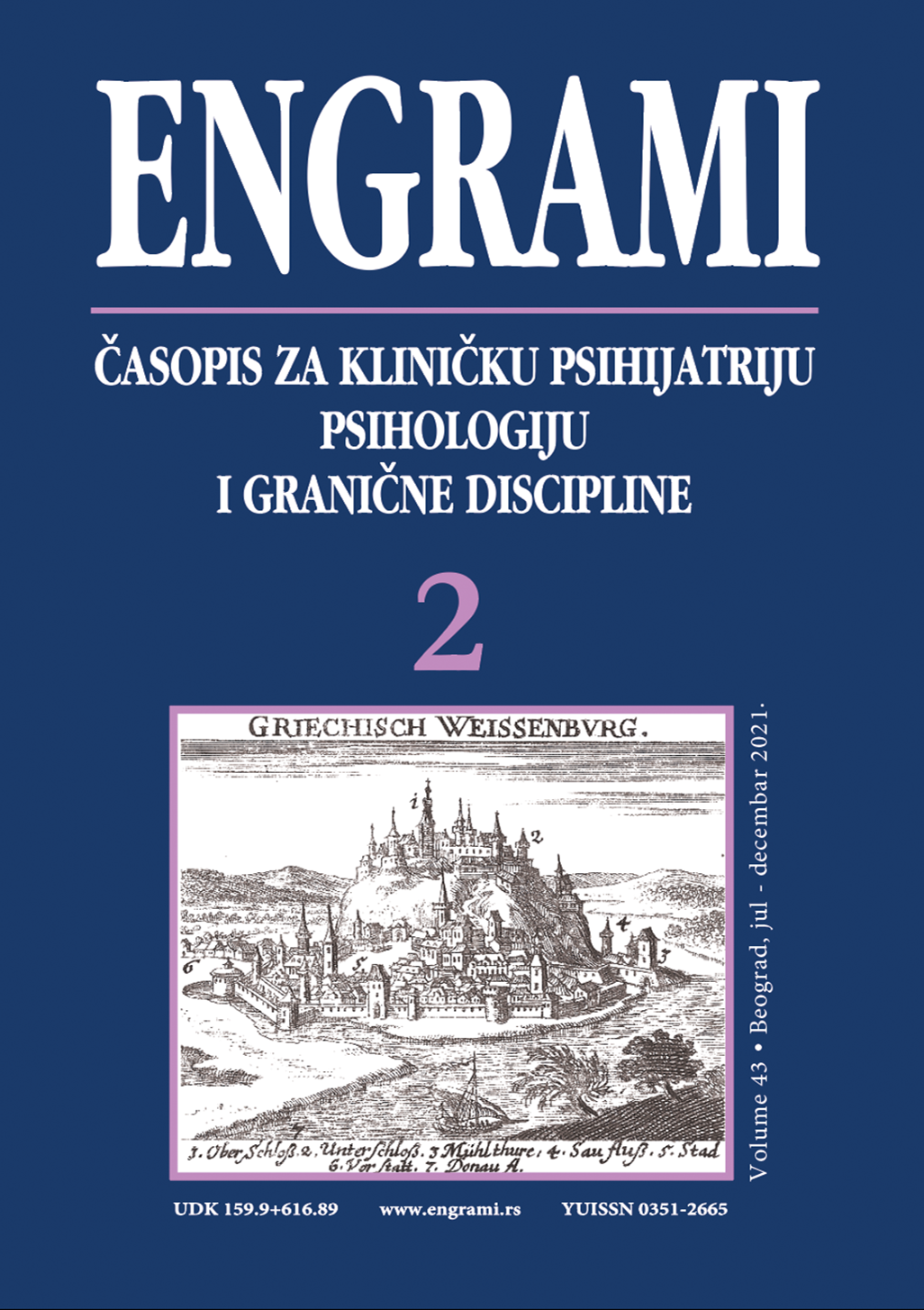Predictors of depression, anxiety and stress during the first wave of the COVID-19 pandemic: The results of an online survey in Serbia
Abstract
Background: The outbreak of the COVID-19 pandemic has affected the mental health of the population worldwide.
Aim: Assessment of risk factors for symptoms of anxiety, depression, and stress during the first wave of the COVID-19 pandemic.
Methods: An online survey including 161 participants was conducted in a population of both healthy participants and people who tested positive to COVID-19. The survey collected socio-demographic data, knowledge about the pandemic, psychological impact, and mental health status of the participants. The psychological impact on mental health status was assessed using the Depression, Anxiety, and Stress Scale (DASS-21). Logistic regression was used to determine the risk factors that increased the likelihood of having symptoms of depression, anxiety, and stress.
Results: A total of 63.8 % of participants showed symptoms of anxiety, with 31.6% showing moderate symptoms of anxiety. Symptoms of depression were found in 44.1% of the sample, with 23.7% showing moderate symptoms of depression, according to DASS-21 cut-off criteria. No mental health history, a positive test for COVID-19, physical health status, and time point of assessment were the most significant factors predicting symptoms of depression. In relation to symptoms of anxiety, we observed the importance of physical health, having offspring and testing positive for COVID-19, and being male. Factors that influenced higher degrees of stress were: testing positive for COVID-19, special nutrition, having offspring, and being of low physical health.
Conclusion: Our study indicates that during the COVID-19 pandemic in Serbia several factors could be important for the development of stress, depression, and anxiety and can be used as a basis for larger, population-based studies. Based on such future studies, evidence-based preventive mental health measures could be implemented in Serbia.
References
- Objave centra za javno zdravlje [Internet]. 2020. Available from: https://covid19.rs/objave-centra-za-javno-zdravlje/
- Bao Y, Sun Y, Meng S, Shi J, Lu L. 2019-nCoV epidemic: address mental health care to empower society. Vol. 395, The Lancet. 2020. p. e37–8.
- Hall RCW, Hall RCW, Chapman MJ. The 1995 Kikwit Ebola outbreak: lessons hospitals and physicians can apply to future viral epidemics. Gen Hosp Psychiatry. 2008;30(5):446–52.
- Van Bortel T, Basnayake A, Wurie F, Jambai M, Koroma AS, Muana AT, et al. Psychosocial effects of an Ebola outbreak at individual, community and international levels. Bull World Health Organ. 2016;
- Rajkumar RP. COVID-19 and mental health: A review of the existing literature. Asian J Psychiatr. 2020;52.
- Jovanović V, Gavrilov-Jerković V, Žuljević D, Brdarić D. Psihometrijska evaluacija skale depresivnosti, anksioznosti i stresa-21 (DASS-21) na uzorku studenata u srbiji. Psihologija. 2014;47(1):93–112.
- IBM Corporation. IBM SPSS Statistics for Windows. Armonk, NY: IBM Corp.; 2011.
- Verma S, Mishra A. Depression, anxiety, and stress and socio-demographic correlates among general Indian public during COVID-19. Int J Soc Psychiatry. 2020;66(8):756–62.
- Terluin B, van Marwijk HWJ, Adèr HJ, de Vet HCW, Penninx BWJH, Hermens MLM, et al. The Four-Dimensional Symptom Questionnaire (4DSQ): A validation study of a multidimensional self-report questionnaire to assess distress, depression, anxiety, and somatization. BMC Psychiatry. 2006;6.
- Kendler KS, Karkowski LM, Prescott CA. Causal relationship between stressful life events and the onset of major depression. Am J Psychiatry. 1999;156(6):837–41.
- Yang L, Zhao Y, Wang Y, Liu L, Zhang X, Li B, et al. The Effects of Psychological Stress on Depression. Curr Neuropharmacol. 2015;13(4):494–504.
- Wang C, Pan R, Wan X, Tan Y, Xu L, Ho CS, et al. Immediate psychological responses and associated factors during the initial stage of the 2019 coronavirus disease (COVID-19) epidemic among the general population in China. Int J Environ Res Public Health. 2020;17(5).
- Shigemura J, Ursano RJ, Morganstein JC, Kurosawa M, Benedek DM. Public responses to the novel 2019 coronavirus (2019-nCoV) in Japan: Mental health consequences and target populations. Vol. 74, Psychiatry and Clinical Neurosciences. 2020. p. 281–2.
- Alexander JL, Dennerstein L, Kotz K, Richardson G. Women, anxiety and mood: a review of nomenclature, comorbidity, and epidemiology. Vol. 7, Expert review of neurotherapeutics. 2007. p. S45–58.
- Wang C, Horby PW, Hayden FG, Gao GF. A novel coronavirus outbreak of global health concern. Vol. 395, The Lancet. 2020. p. 470–3.
- Jerotic S. Sex differences in the trauma-related symptoms: A pilot study. Med Podml. 2016;67(3):68–73.
- Asmundson GJG, Taylor S. How health anxiety influences responses to viral outbreaks like COVID-19: What all decision-makers, health authorities, and health care professionals need to know. Vol. 71, Journal of Anxiety Disorders. 2020.
- Page LA, Seetharaman S, Suhail I, Wessely S, Pereira J, Rubin GJ. Using electronic patient records to assess the impact of swine flu (influenza H1N1) on mental health patients. J Ment Heal. 2011;20(1):60–9.
- Xiao H, Zhang Y, Kong D, Li S, Yang N. The effects of social support on sleep quality of medical staff treating patients with coronavirus disease 2019(COVID-19) in January and February 2020 in China. Med Sci Monit. 2020;26.
- Zandifar A, Badrfam R. Iranian mental health during the COVID-19 epidemic. Vol. 51, Asian Journal of Psychiatry. 2020.
- Bontcheva K, Gorrell G, Wessels B. Social Media and Information Overload: Survey Results. arXiv Prepr arXiv13060813 [Internet]. 2013; Available from: http://arxiv.org/abs/1306.0813
- Asmundson GJG, Taylor S. Coronaphobia: Fear and the 2019-nCoV outbreak. Vol. 70, Journal of Anxiety Disorders. 2020.

